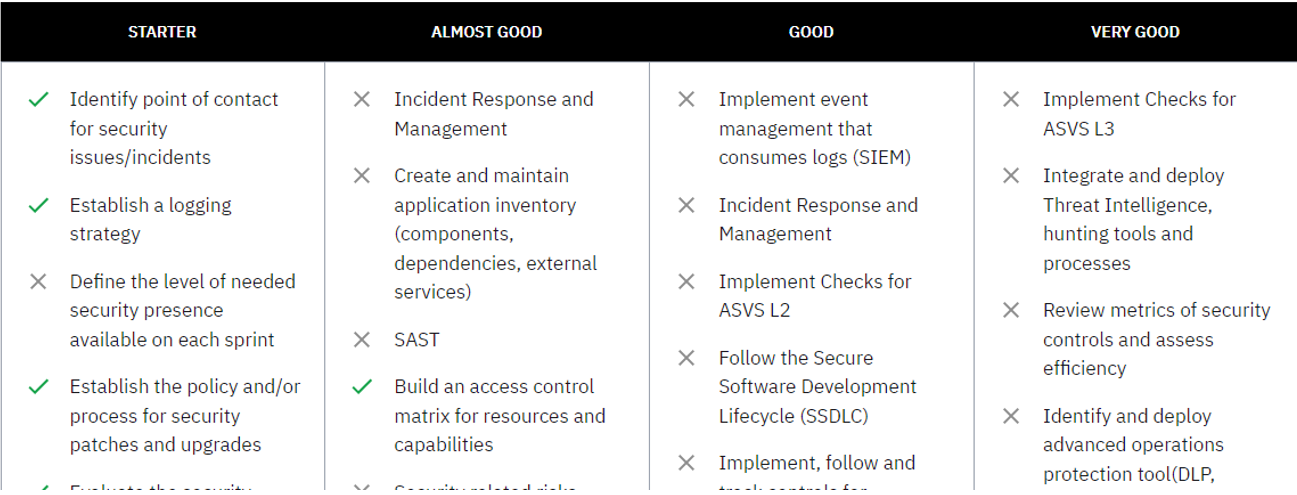Why and how we use maturity models in Pentalog
- Are maturity models still relevant?
- Can they add value in today’s dynamic environment?
- If yes, how should they be used?
These are good questions, and this article will help you understand the answers, and how you can benefit from the maturity models we offer in Pentalog.

What is a maturity model?
A maturity model is a tool for assessing the current state, risks, and effectiveness of a system; a tool that supports figuring out the capabilities needed to acquire next to improve the system’s performance. In many circles, maturity models have gained a bad reputation, but although they can easily be misused, in the right hands, they can be extremely helpful.
* This definition was adapted from Martin Fowler’s article MaturityModel.
In Pentalog, we have a dozen maturity models. Here is the one for Security:

As shown, the model contains four columns, each with multiple items. This is true for all our maturity models. The four columns are:
- Starter
- Almost good
- Good
- Very good
We created these columns deliberately different from other maturity models because we wanted to simplify things. In these columns, we have captured the type of risk or opportunity you have by being in that state.
For example, we consider the “Starter“ column to be the one that needs to happen as soon as our collaboration starts. Without it, you (our customer) and we are at immediate risk of failure. One of the reasons for failure is the lack of alignment on expectations. This is why for us in Pentalog, completing all items in the Starter column is non-negotiable. From the start of a collaboration, we plan to cover all Starter items in all maturity models in the first 2-3 months.
While not having the items “Almost good” done does not pose an immediate risk, we are still at risk of failure and suffering from many problems slowing us down in trying to create value. The items in this next column are the core – of good practices in the industry.
Doing the items in the “Good” column means that we are not only reducing operational risk, but are also now optimizing value delivery. This column will push us forward, and investing here will give better results both now and in the future. The idea of optimization is paying the price now to save in the future.
We call the last column “Very good”, which might be an understatement. We have considered for a long time that a better-suited name would be Excellent, because the items here go beyond optimization to offer competitive advantages. Only the best reach this state in this endless investment possibilities market.
There you have it – a brief introduction to our Maturity Models, their value, and their meaning.
Frequently asked questions
Why did you create these maturity models?
Pentalog was founded in 1993. Over these almost 30 years, we have delivered great products for clients from many industries. In the last few years, we have had 200+ clients per year. From all this experience, we started to notice patterns and good practices: what works and what doesn’t. We captured these patterns in our services and the practices in the maturity models (the four columns and their meaning) and the items you will find in each column.
Learn more about our agile governance practices >
How will the maturity models help me?
> Most of the answer to this central question is in the article above, but to summarize: by understanding and using the models, you control the risk we take and the value we deliver.
We use them extensively in all our client projects and for activities like audits or due diligence. They are great for:
- Formulating the technology strategy of a company (CTOs)
- Explaining technology decisions and translating them for non-technical people (CTOs)
- Understanding the overall state of technology and deciding where to invest energy (CTOs, POs, Engineering Managers)
- Creating technical roadmaps or extending product roadmaps with the right technical topics (POs)
- Understanding the overall risk a company faces (CEOs, CTOs, and other Decision-Makers)
- Understanding the industry’s best practices and learning (most technology roles including CTOs, Engineering Managers, Architects, Technical or Team Leads, Software Engineers, QAs, DevOps, and more)
How many maturity models do you have in Pentalog?
> We have twelve maturity models at the time of writing, and we expect them to evolve both in number and content. They cover areas like architecture, engineering practices, governance, infrastructure, team staffing and skills, quality, and more.
Where can I see all twelve maturity models and their items?
You can create a free account on pentalog.com that will give you access to a demo dashboard that contains all our maturity models.
Create your Pentalog account >
What level should I reach for each maturity model?
> That’s up to you. The purpose of our maturity models is to give you choices and better understand the consequences of those choices. For example, choosing not to do the items in the “Starter” column means living with the risk of immediate failure. Or choosing to reach the “Good” level means you are committed to investing in optimizing value delivery.
We won’t be able to work together unless we commit to implementing at least the Starter column. We want this for all our clients and for all maturity models.
The rest depends on the product context (funding, risk appetite, company lifecycle stage, industry regulations, etc.). For some products, it will make sense to invest and reach the “Very good ” level for a particular maturity model, while for other products, the focus would be on another level. Improving the maturity of a company is a journey, not a one-off event.
Here is a concrete example:
- If you are a FinTech startup you will aim for the “Very good” level in Security because you handle extremely sensitive data.
- A startup that is offering an educational platform for high school students will instead aim for “Almost good” on the same maturity model.
We will help you decide what level to reach on each maturity model.
I need help understanding all the items on the list. What do I need to do to progress through the maturity models?
> All items have acceptance criteria that help you understand whether you can consider them done.
Do you need more information?
- Create a Pentalog account to get a preview of Maturity Models implementation.
- Request a live demo. My team and I will be happy to walk you through our processes.
Further reading:
DORA Metrics as part of Pentalog’s Maturity Models


 (16 votes, average: 4.81 out of 5)
(16 votes, average: 4.81 out of 5)







